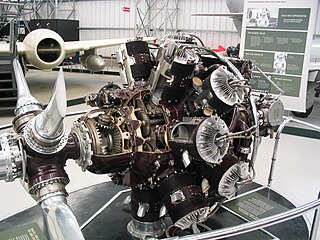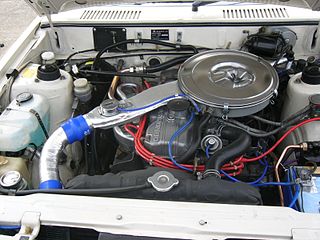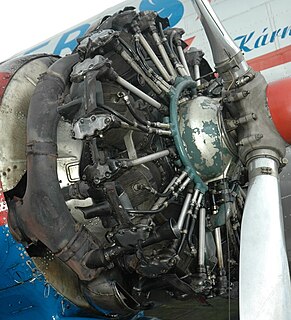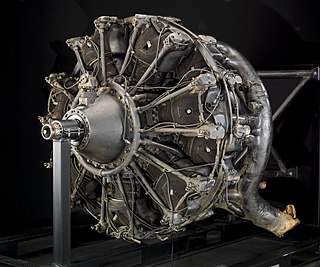Related Research Articles

The Bristol Hercules is a 14-cylinder two-row radial aircraft engine designed by Sir Roy Fedden and produced by the Bristol Engine Company starting in 1939. It was the most numerous of their single sleeve valve designs, powering many aircraft in the mid-World War II timeframe.

The 12Z, designated Type 89 by the company, was the final evolution of the series of Hispano-Suiza V-12 aircraft engines. The Z model had just entered production when France fell to the Germans during World War II. A small number were produced during the war but the German occupation government would not allow full-scale production to start. After the war small numbers were built to equip new designs, but the rapid introduction of the jet engine ended further development.

The Pratt & Whitney R-1690 Hornet was a widely used American aircraft engine. Developed by Pratt & Whitney, 2,944 were produced from 1926 through 1942. It first flew in 1927. It was a single-row, 9-cylinder air-cooled radial design. Displacement was 1,690 cubic inches. It was built under license in Italy as the Fiat A.59. In Germany, the BMW 132 was a developed version of this engine. The R-1860 Hornet B was an enlarged version produced from 1929.

The Mitsubishi Kasei was a two-row, 14-cylinder air-cooled radial engine built by Mitsubishi Heavy Industries and used in a variety of World War II Japanese aircraft, such as Mitsubishi J2M and Mitsubishi G4M. The Mitsubishi model designation for this engine was A10 while it was an experimental project, in service it was known as the MK4, and known as the Ha101 & Ha111 by the Army and Kasei by the Navy. According to unified designation code it was Ha-32 of the variants from 11 to 27.

The Mitsubishi Astron or 4G5/4D5 engine, is a series of straight-four internal combustion engines first built by Mitsubishi Motors in 1972. Engine displacement ranged from 1.8 to 2.6 litres, making it one of the largest four-cylinder engines of its time.

The 6G7 series or Cyclone V6 engine is a series of V6 piston engines from Mitsubishi Motors. Five displacement variants were produced from 1986 to 2021, with both SOHC and DOHC, naturally aspirated and turbo charged layouts. While MIVEC variable valve timing has also been implemented in some versions the 2.5, 3.0 and 3.5 L versions were also available with gasoline direct injection. This engine has been the flagship powerplant of the company except when they briefly built a V8 in 1999–2001. The staple of their high-end sedans, it was given twin-turbos for the Mitsubishi GTO, and became the most powerful car ever built by the company at the time.

The Bramo 323 Fafnir is a nine-cylinder radial aircraft engine of the World War II era. Based heavily on Siemens/Bramo's earlier experience producing the Bristol Jupiter under licence, the Bramo 323 saw limited use.

The Klimov VK-107 was a V-12 liquid-cooled piston aircraft engine used by Soviet aircraft during World War II.
The Mitsubishi 4M4 engine is a range of four-cylinder diesel piston engines from Mitsubishi Motors, first introduced in the second generation of their Montero/Pajero/Shogun SUVs. They superseded the previous 4D5 engine family, main differences are enlarged displacements and the utilization of one or two over-head camshafts. Originally available only as a 2835 cc intercooled turbo, detail improvements in 1996 and a larger 3.2 litre option in 1999 served to improve power, torque, fuel economy and emissions. The final version has 3.0 litres swept volume and Common rail direct injection.

The Shvetsov ASh-62 is a nine-cylinder, air-cooled, radial aircraft engine produced in the Soviet Union. A version of this engine is produced in Poland as the ASz-62 and the People's Republic of China as the HS-5.

The Fiat A.74 was a two-row, fourteen-cylinder, air-cooled radial engine produced in Italy in the 1930s as a powerplant for aircraft. It was used in some of Italy's most important aircraft of World War II.

The Armstrong Siddeley Cougar was an aero engine developed by Armstrong Siddeley in 1945. The design was a departure from earlier Armstrong Siddeley engines in many ways, it was the company's only nine-cylinder radial design. Although the engine was tested it did not find an aircraft application and was not produced.
The Nakajima Ha5 is a twin row, 14 cylinder air-cooled radial aircraft engine built by the Japanese Nakajima Aircraft Company. The engine was a development of earlier single-row Japanese engines, the Kotobuki and Hikari, which had combined features of the Bristol Jupiter and Pratt & Whitney R-1340 Wasp designs.

The Nakajima Mamoru engine was a 14-cylinder, air-cooled, two-row radial engine of 1870 hp. At some 44.9 litres displacement, it was one of the largest-displacement 14-cylinder radial engines in the world, rivalling the similar configuration Allies' American Wright Twin Cyclone engine of 42.7 litre and Soviet Shvetsov ASh-82 engine of 41.2 litre displacement levels, and was meant to compete with early 18-cyl engines. The Nakajima model designation for this engine was NAK while it was an experimental project, in service it was known as the NK7, and known as the Ha-103 by the Army and "Mamori" or "Mamoru" by the Navy. According to unified designation code it was Ha-36. The meanings of these two Japanese words are very similar, Mamori translates as protection and Mamoru, translates as to guard, protect, defend and obey.
The Mitsubishi Shinten was a two-row, 14-cylinder air-cooled radial engine built by the Mitsubishi Aircraft Company for the Imperial Japanese Army Air Service (IJAAS) and the Imperial Japanese Navy Air Service (IJNAS) in the early 1930s. Like many aircraft engines in Japan, there were multiple designations for this engine. The company model designation was A6(7) while it was an experimental engine project. Once accepted, it was known as the "Shinten" or MK1 by the IJNAS, and Ha6 by the IJAAS.
The Mitsubishi Zuisei was a 14-cylinder, supercharged, air-cooled, two-row radial engine used in a variety of early World War II Japanese aircraft. It was one of the smallest 14-cyl. engines in the world and the smallest diameter Japanese engine. The Mitsubishi model designation for this engine was A14 while it was an experimental project, in service it was known as the MK2, followed by the revision code letter, and known as the Ha26 & Ha102 by the Army and "Zuisei" by the Navy. Unified designation code was [Ha-31].
The Piaggio P.XIX was an Italian aircraft engine produced by Rinaldo Piaggio S.p.A. during World War II and used to power aircraft of the Regia Aeronautica.
The Mitsubishi Ha-43, known as the Ha-211 by the Imperial Japanese Army Air Force (IJAAF) and MK9 by the Imperial Japanese Navy Air Service (IJNAS)), was a Japanese 18-cylinder, twin-row air-cooled radial engine developed during World War II. It was a more powerful derivative of Mitsubishi's 14-cylinder Kinsei. While planned for use in several promising aircraft, only prototypes were made and the engine never saw combat.
References
- ↑ Gunston, Bill (1989). World Encyclopaedia of Aero Engines. Cambridge, England: Patrick Stephens Limited. p. 104. ISBN 1-85260-163-9.
- ↑ Goodwin 2017, p. 101.
- ↑ Peattie, Mark R. (2001). Sunburst: The Rise of Japanese Naval Air Power, 1909-1941. Annapolis, Maryland: Naval Institute Press. p. 308. ISBN 1-55750-432-6.
- ↑ Goodwin 2017, p. 90.
- ↑ Goodwin 2017, p. 103.
- ↑ Goodwin 2017, p. 89.
- ↑ Goodwin 2017, p. 119-121.
- ↑ Gunston, Bill (1989). Jane's Fighting Aircraft of World War II. London: Studio Editions Ltd. p. 298. ISBN 0-517-67964-7.
- Goodwin, Mike (2017). Japanese Aero-Engines 1910-1945. Sandomierz, Poland: MMPBooks. ISBN 978-83-65281-32-6.
{{cite book}}: CS1 maint: date and year (link)